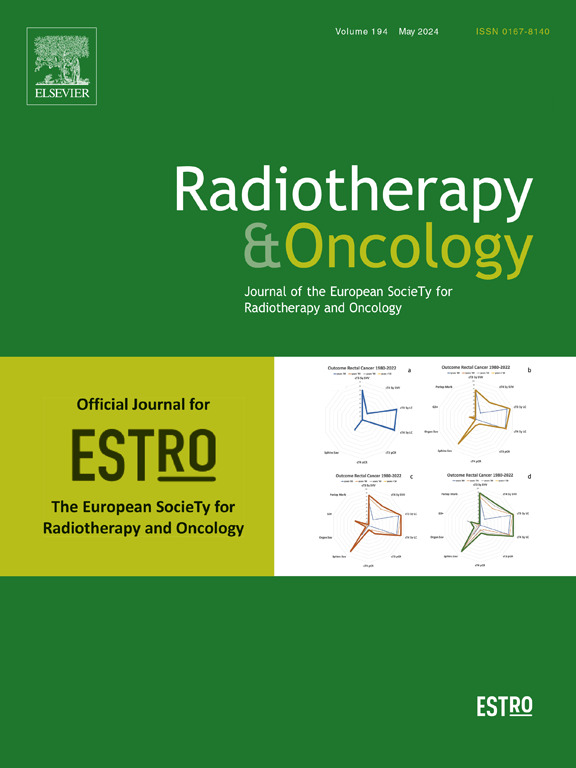On the PTV homogeneity objective in the era of photon advanced dose calculation algorithms: Bridging robust and PTV-based planning
IF 4.9
1区 医学
Q1 ONCOLOGY
引用次数: 0
Abstract
Aim
The planning target volume (PTV) homogeneity objective was developed for previous-generation dose calculation algorithms. Advanced algorithms report doses to medium-in-medium (Dm,m) and their values depend on the medium considered, breaking the link between uniform irradiation and dose homogeneity. This work revises the PTV homogeneity objective when high-density heterogeneities are involved. We evaluated robust against PTV-based planning, and a dose reporting method that removes composition dependencies to express doses to muscle in muscle-like medium (Dmuscle,muscle*).
Methods
Four cases featuring bone or metal within the PTV were selected and planned in RayStation with Monte Carlo. Three plans were created for each case: robust optimization for Dm,m (Robust-Dm,m), and PTV-based optimization for Dm,m (PTV-Dm,m) and Dmuscle,muscle* (PTV-Dmuscle,muscle*). The plans were reported in Dm,m and Dmuscle,muscle*, and their dosimetric parameters, robustness, complexities, and optimization times were assessed.
Results
Robust-Dm,m and PTV-Dmuscle,muscle* plans presented similar Dm,m distributions with inhomogeneous PTV doses due to cold spots in high-density regions. PTV-Dm,m plans achieved homogeneous PTV doses but required local fluence compensations that impaired robustness, with significant hot spots, and increased complexity. Robust optimization was 7 to 11 times slower. Reporting in Dmuscle,muscle* restored consistency between PTV-based and robust evaluations.
Conclusions
Robust optimization proves that PTV homogeneity should not be prioritized when advanced algorithms reporting Dm,m are used with high-density heterogeneities. PTV-Dmuscle,muscle* optimization offers a practical alternative for maintaining PTV-based planning and the PTV homogeneity objective while ensuring consistency with robust optimization. Dmuscle,muscle* reporting simplifies plan evaluation and aligns with clinical practice, facilitating decision-making in treatment planning.
光子高级剂量计算算法时代PTV均匀性目标:桥接鲁棒性和基于PTV的规划
目的为上一代剂量计算算法建立计划靶体积(PTV)均匀性目标。先进的算法报告中中剂量(Dm,m)及其值取决于所考虑的介质,从而打破了均匀照射与剂量均匀性之间的联系。当涉及到高密度的非均质性时,本工作修正了PTV均匀性目标。我们对基于pvt的计划和剂量报告方法进行了稳健评估,该方法消除了成分依赖性,以表达肌肉样培养基中肌肉的剂量(Dmuscle,muscle*)。方法选择4例PTV内有骨或金属的病例,在蒙特卡洛射线工作站中进行规划。针对每种情况创建了三个方案:Dm,m的鲁棒优化(robust -Dm,m)和Dm,m (PTV-Dm,m)和Dmuscle,muscle* (PTV-Dmuscle,muscle*)的基于ptv的优化。在Dm、m和Dmuscle、muscle*中报道了这些方案,并评估了它们的剂量学参数、稳健性、复杂性和优化时间。结果robust -Dm,m和PTV- dmuscle,muscle*图Dm,m分布相似,但由于高密度区存在冷点,PTV剂量不均匀。PTV- dm,m计划实现了均匀的PTV剂量,但需要局部影响补偿,这损害了鲁棒性,具有显著的热点,并增加了复杂性。鲁棒优化速度要慢7到11倍。在Dmuscle报告中,muscle*恢复了基于ptv和稳健评估之间的一致性。结论鲁棒优化证明,当报告Dm、m的高级算法用于高密度异构性时,不应优先考虑PTV均匀性。PTV- dmuscle,muscle*优化为维护PTV为基础的规划和PTV同质性目标提供了一个实用的替代方案,同时确保与鲁棒优化的一致性。Dmuscle,muscle*报告简化了计划评估,并与临床实践保持一致,促进了治疗计划的决策。
本文章由计算机程序翻译,如有差异,请以英文原文为准。
求助全文
约1分钟内获得全文
求助全文
来源期刊

Radiotherapy and Oncology
医学-核医学
CiteScore
10.30
自引率
10.50%
发文量
2445
审稿时长
45 days
期刊介绍:
Radiotherapy and Oncology publishes papers describing original research as well as review articles. It covers areas of interest relating to radiation oncology. This includes: clinical radiotherapy, combined modality treatment, translational studies, epidemiological outcomes, imaging, dosimetry, and radiation therapy planning, experimental work in radiobiology, chemobiology, hyperthermia and tumour biology, as well as data science in radiation oncology and physics aspects relevant to oncology.Papers on more general aspects of interest to the radiation oncologist including chemotherapy, surgery and immunology are also published.
 求助内容:
求助内容: 应助结果提醒方式:
应助结果提醒方式:


